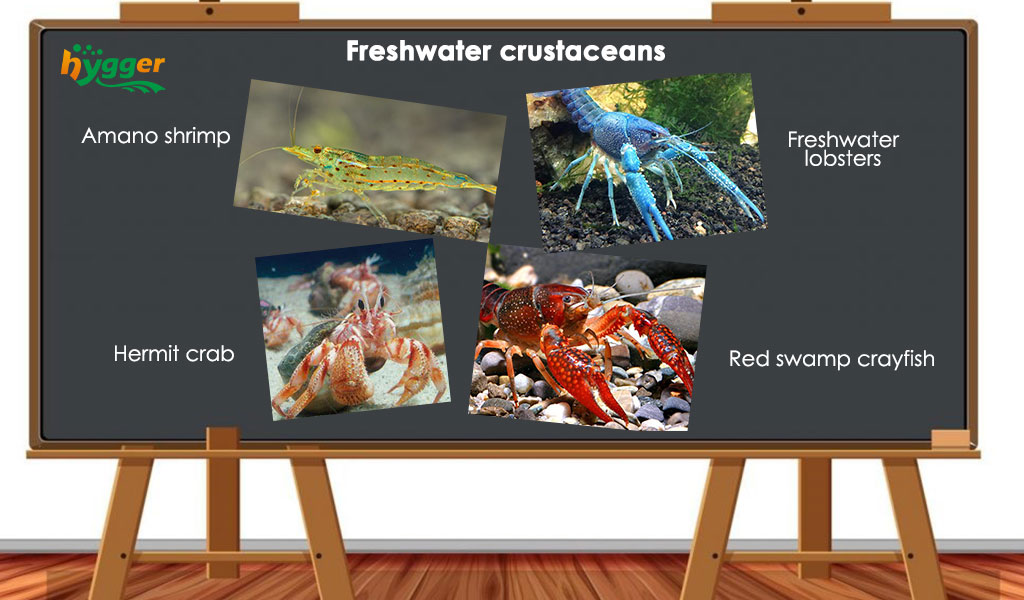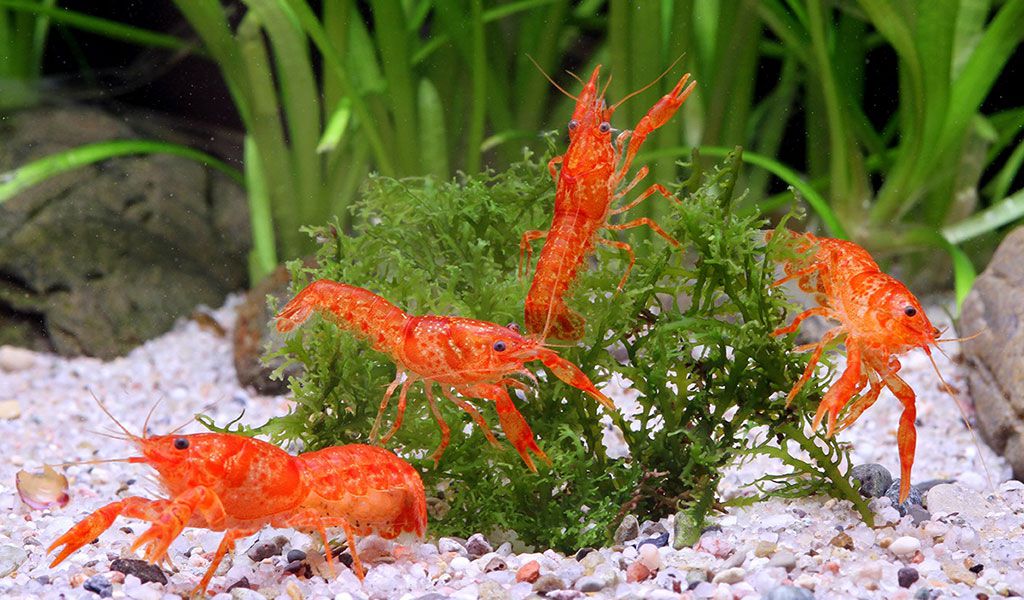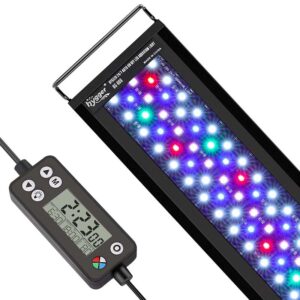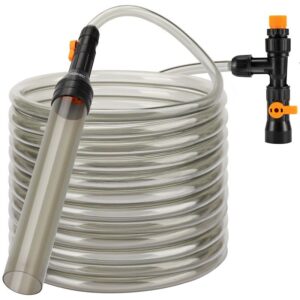In freshwater aquariums, except for aquarium decors, various freshwater crustaceans can be a great addition, featuring unique characteristics. So here in this article, we are going to discuss something about freshwater crustaceans, like their characteristics, classification, and diet. Without wasting much time, let’s dive into the topic.
Content Table
What Are Crustaceans
Get into freshwater crustaceans
Freshwater crustaceans can be found in streams. Featuring a hard and jointed exoskeleton, crustaceans come in various colors and patterns. Also, they have gills for breathing.
Crustaceans can be great tank cleaners. Some are scavengers, which consume uneaten fish food to keep clean aquariums. While some do well in algae control. They consume algae in aquariums. For instance, ghost shrimp, Amano shrimp, and Cherry shrimp.
Besides that, crustaceans will molt as they grow up. During the molting period, they will burrow or hide. The molting process commonly takes a few minutes or a few hours. Hence, the substrate should not be sharp. Otherwise, crustaceans may be injured. Also, you’d better keep crustaceans in tanks with plenty of hiding places.
Most freshwater crustaceans are omnivorous. The adult size and average lifespan can be varied from diverse species. But most of them prefer a water temperature ranging from 72 ℉ to 82 ℉. The minimum tank size should not be less than 5 gallons. Just determine it according to the crustacean species. For example, many shrimp prefer living in groups. Accordingly, the tank should be larger to avoid overcrowding.
A list of freshwater crustaceans
Next, we will give a brief list of popular freshwater crustaceans.
| Algae shrimp | Amano shrimp | Hermit crab |
| Bamboo shrimp | Cherry shrimp | Freshwater lobsters (e.g. Blue lobsters, Vanilla lobsters, Tangerine lobsters) |
| Ghost shrimp | Crystal shrimp | Crayfish (e.g. Red swamp crayfish, Dwarf orange crayfish) |

Compatible tank mates for freshwater crustaceans
Among freshwater crustaceans, some species are territorial, like freshwater lobsters and crayfish. Thus, to keep your tank balanced and peaceful, you’d better keep them with compatible tank mates. Given below are some excellent choices.
| Small tetras | Platy fish | Hatchet fish |
| Dwarf gouramis | Rainbow fish | Killifish |
| Guppy fish | Rasbora | Small danios |
What Do Crustaceans Eat
A balanced diet is undisputed. Generally, the available foods include uneaten fish food, debris in your tank, fallen leaves of live plants, algae, organic matter, sinking pellets, wafers, flakes, frozen food, etc. In molting crustaceans, they require extra food to form new exoskeletons.
Let’s give you some examples. Take a look at lobsters first. In captivity, algae, plants, dead aquatic pets, worms, and some commercial food can be their diet. On the other side, hermit crabs eat vegetables and fruits. Also, hermit crabs need to drink water. Therefore, you should provide clean freshwater or saltwater. But do not use tap water. Since the chlorine and minerals in tap water are harmful to hermit crabs. By the way, most hermit crabs are nocturnal. Consequently, it is best to feed them at night.
Aside from that, ghost shrimp are great scavengers. The leftovers on the bottom of the fish tank can be a food source for them. Also, algae, aquatic plants, larvae, and pellets are available foods. Actually, as omnivorous pets, you can feed ghost shrimp varieties of foods.

Are Shrimp Crustaceans
Shrimp are crustaceans. As for crustaceans, shrimp are also easy to keep. They are not picky eaters and eat almost everything. So, as for the cost of food, they are lower cost. In this segment, let’s take a look at freshwater aquarium shrimp.
- The available food sources include aquatic plant leaves, vegetables (e.g. Cucumber, Zucchini, Spinach), algae, biofilm, cuttlebone, bloodworms, brine shrimp, daphnia, and pellets.
- Some shrimp are nocturnal. They will hide in aquariums, while they will be active and eat at night. For example, the Peppermint shrimp, Amano shrimp, and Ghost shrimp.
- Introducing shrimp is beneficial to keep fish tanks clean. Aside from removing algae, some shrimp also make sense in cleaning aquarium glass by stripping algae from the aquarium walls.
- Shrimp are easy to breed. Because they can carry the eggs underneath the body.
- The same as most crustaceans, freshwater shrimp can molt. You may be surprised about it. They often molt at young ages. It is common for shrimp to melt once a week.
- Shrimp are great swimmers, and they usually walk around aquariums.
If you want to know more about shrimp in aquariums, you can go to:
Signs of a Healthy Crustacean
Unhealthy crustaceans can pose threats to your tank. Then, how can you tell whether they are healthy or not? Here are some signs of healthy and unhealthy crustaceans.
| Signs | |
| Healthy crustaceans | 1. Even color 2. Great appetite 3. Active in the aquarium 4.No missing appendages or antennas |
| Unhealthy crustaceans | 1. Color fading 2. Loss of appetite 3. Spots or fungus on the body 4. Inactive 5. Missing appendages or antennas 6. Body or surface erosion 7. White growth on the head |
The Bottom Line
Crustaceans are not picky eaters, making them an excellent alternative in aquariums. To keep crustaceans healthy, here are some pointers for you.
- Provide an appropriate tank size and make sure plenty of hiding places and space. Overcrowded tanks will cause stress or even disease to crustaceans.
- Maintaining great water quality and stable water parameters is vital for crustaceans.
- Do regular water changes. For instance, change 10-25 percent of water every two weeks.
- Build a great filtration system. And change the filter media once each month.
- Monitor water temperature daily and test the water once each week.
- To grow crustaceans’ shells, you’d better provide sufficient calcium.
- Never apply copper-based medications, which are toxic to crustaceans.
- Introduce new aquatic pets gradually.
That’s all for today. For additional information about freshwater crustaceans, welcome to share with us in the comment. We are happy to receive your sharing. Finally, thanks for your time and we hope this article helps. Best wishes for your aquarium journey.


Leave a comment